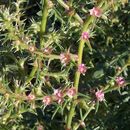Description
(
Inglês
)
fornecido por Phytokeys
Annuals or subshrubs, glabrous or papillate, with tufts of simple curved hairs in the leaf axils. Leaves mostly alternate or lower leaves opposite, semi-terete or terete, sometimes flattened, usually less than 5 mm in width, stiff or fleshy, with a persistent yellowish mucro up to 3.5–4.0 mm long. Bracts longer than bracteoles or equal in size. Flowers of two types: some located below the main inflorescence and arranged in clusters mostly consisting of two female flowers supported by concrescent and basally hardened bracts and bracteoles, rarely clusters one-flowered (these fall off with bracts and bracteoles), perianth r-shaped, usually with small wings, tubercles or without any projections in the flexure; flowers of the second type grouped in the main inflorescence, hermaphrodite, each flower supported by a free bract and two bracteoles (rarely concrescent), r-shaped or tubuliform at fruiting (in the latter case, the segments in their upper part are convergent, forming a stout or hyaline conus that covers the fruit from above). Perianth of (4)5 segments, with well-developed, equal or unequal wings or tubercles at the fruiting stage. Stamens (in the hermaphrodite flowers) 5, divided in the lower half, without prominent appendages at the tip of the anthers. Stigmas 2, usually equal to style (or a style is very short). Fruits dry or somewhat fleshy in the upper part. Seeds with horizontal or obliquely orientated embryo (sometimes seems to be vertical due to anacrostyly). Perisperm absent.
Approximately 22 species in the steppes, seashores and deserts of Eurasia, North America, Africa and Australia.
- licença
- cc-by-3.0
- direitos autorais
- Alexander P. Sukhorukov, Pei-Liang Liu, Maria Kushunina
- citação bibliográfica
- Sukhorukov A, Liu P, Kushunina M (2019) Taxonomic revision of Chenopodiaceae in Himalaya and Tibet PhytoKeys (116): 1–141
- autor
- Alexander P. Sukhorukov
- autor
- Pei-Liang Liu
- autor
- Maria Kushunina

